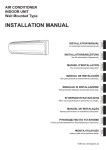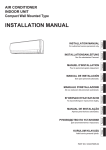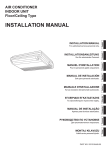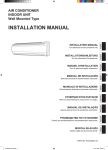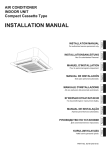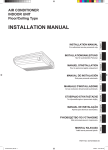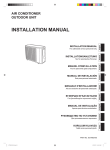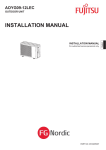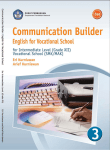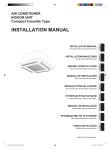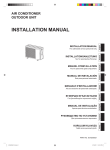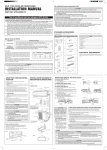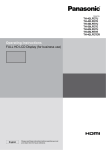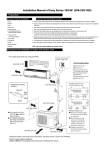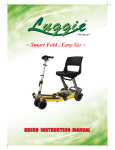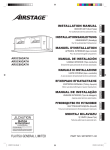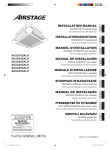Download INSTALLATION MANUAL
Transcript
AIR CONDITIONER INDOOR UNIT Wall Mounted Type Sólo para personal de mantenimiento autorizado. MANUALE DI INSTALLAZIONE Esclusivamente destinato al personale autorizzato. ΕΓΧΕΙΡΙΔΙΟ ΕΓΚΑΤΑΣΤΑΣΗΣ Μόνο για εξουσιοδοτημένο προσωπικό του σέρβις. MANUAL DE INSTALAÇÃO Apenas para técnicos de assistência autorizados. РУКОВОДСТВО ПО УСТАНОВКЕ Только для авторизованного обслуживающего персонала. MONTAJ KILAVUZU Sadece yetkili servis personeli içindir. PART NO. 9315342874-03 Deutsch Français Español MANUAL DE INSTALACIÓN Italiano Pour le personnel agréé uniquement. EλληvIkά MANUEL D'INSTALLATION Português Nur für autorisiertes Fachpersonal. Русский INSTALLATIONSANLEITUNG Türkçe INSTALLATION MANUAL For authorized service personnel only. English INSTALLATION MANUAL INSTALLATION MANUAL CAUTION PART NO. 9315342874-03 INDOOR UNIT (Wall Mounted Type) Read carefully all security information before use or install the air conditioner. Do not attempt to install the air conditioner or a part of the air conditioner by yourself. Contents 1. SAFETY PRECAUTIONS ............................................................................................ 1 2. ABOUT THE UNIT ....................................................................................................... 1 2.1. Precautions for using R410A refrigerant ............................................................ 1 2.2. Special tools for R410A ...................................................................................... 1 2.3. For authorized service personnel only. .............................................................. 2 2.4. Accessories ........................................................................................................ 2 2.5. Optional parts ......................................................................................................... 2 3. This unit must be installed by quali¿ed personnel with a capacity certi¿cate for handling refrigerant Àuids. Refer to regulation and laws in use on installation place. The installation must be carried out in compliance with regulations in force in the place of installation and the installation instructions of the manufacturer. This unit is part of a set constituting an air conditioner. It must not be installed alone or with non-authorized by the manufacturer. Always use a separate power supply line protected by a circuit breaker operating on all wires with a distance between contact of 3mm for this unit. The unit must be correctly earthed (grounded) and the supply line must be equipped with a differential breaker in order to protect the persons. The units are not explosion proof and therefore should not be installed in explosive atmosphere. Never touch electrical components immediately after the power supply has been turned off. Electric shock may occur. After turning off the power, always wait 5 minutes before touching electrical components. This unit contains no user-serviceable parts. Always consult authorized service personnel to repairs. GENERAL.................................................................................................................... 2 3.1. Type of copper pipe and insulation material....................................................... 2 3.2. Additional materials required for installation ...................................................... 2 4. ELECTRICAL REQUIREMENT ................................................................................... 2 5. SELECTING THE MOUNTING POSITION ................................................................. 3 6. INSTALLATION WORK ............................................................................................... 3 6.1. Installation dimensions ....................................................................................... 3 6.2. Indoor unit piping direction ................................................................................. 3 6.3. Cutting the hole in the wall for the connecting piping ......................................... 3 6.4. Installing the wall hook bracket .......................................................................... 3 6.5. Forming the drain hose and pipe ....................................................................... 4 6.6. Flare connection (Pipe connection) .................................................................... 4 7. This mark indicates procedures which, if improperly performed, might possibly result in personal harm to the user, or damage to property. When moving, consult authorized service personnel for disconnection and installation of the unit. 2. ABOUT THE UNIT 2.1. Precautions for using R410A refrigerant ELECTRICAL WIRING ................................................................................................ 5 7.1. Wiring system diagram ....................................................................................... 5 7.2. Indoor unit wiring ................................................................................................ 5 7.3. How to connect wiring to the terminals .............................................................. 5 8. FINISHING................................................................................................................... 6 9. FRONT PANEL REMOVAL AND INSTALLATION ...................................................... 6 9.1. Intake grill removal ............................................................................................. 6 9.2. Intake grill installation ......................................................................................... 6 9.3. Front panel removal ........................................................................................... 6 9.4. Front panel installation ....................................................................................... 6 The basic installation work procedures are the same as conventional refrigerant (R22) models. However, pay careful attention to the following points: Since the working pressure is 1.6 times higher than that of conventional refrigerant (R22) models, some of the piping and installation and service tools are special. (See the table below.) Especially, when replacing a conventional refrigerant (R22) model with a new refrigerant R410A model, always replace the conventional piping and Àare nuts with the R410A piping and Àare nuts. 10. TEST RUN ................................................................................................................... 7 Models that use refrigerant R410A have a different charging port thread diameter to prevent erroneous charging with conventional refrigerant (R22) and for safety. Therefore, check beforehand. [The charging port thread diameter for R410A is 1/2 inch.] 11. REMOTE CONTROLLER INSTALLATION.................................................................. 7 11.1. Remote controller holder installation .................................................................. 7 12. OPTIONAL KIT INSTALLATION (OPTION) ................................................................. 7 12.1. Before install optional remote controller ............................................................. 7 12.2. Remote controller cable modi¿cation ................................................................. 7 12.3. External input / output Wire modi¿cation ............................................................ 7 12.4. Front panel, control box cover and display case removal .................................. 8 12.5. Connecting cable to control board connector..................................................... 8 12.6. Front panel, control box cover and display case installation .............................. 8 13. FUNCTION SETTING.................................................................................................. 8 Be more careful that foreign matter (oil, water, etc.) does not enter the piping than with refrigerant (R22) models. Also, when storing the piping ,securely seal the opening by pinching, taping, etc. When charging the refrigerant, take into account the slight change in the composition of the gas and liquid phases. And always charge from the liquid phase where refrigerant composition is stable. 1 2.2. Special tools for R410A 14. CUSTOMER GUIDANCE ............................................................................................ 9 15. ERROR CODES ........................................................................................................ 10 Tool name Contents of change Gauge manifold Pressure is high and cannot be measured with a conventional (R22) gauge. To prevent erroneous mixing of other refrigerants, the diameter of each port has been changed. It is recommended the gauge with seals-0.1 to 5.3 MPa (-1 to 53 bar) for high pressure. -0.1 to 3.8 MPa (-1 to 38 bar) for low pressure. 1 1. SAFETY PRECAUTIONS x x x Be sure to read this Manual thoroughly before installation. The warnings and precautions indicated in this Manual contain important information pertaining to your safety. Be sure to observe them. Hand this Manual, together with the Operating Manual, to the customer. Request the customer to keep them on hand for future use, such as for relocating or repairing the unit. WARNING This mark indicates procedures which, if improperly performed, might lead to the death or serious injury of the user. Request your dealer or a professional installer to install the indoor unit in accordance with this Installation Manual. An improperly installed unit can cause serious accidents such as water leakage, electric shock, or ¿re. If the indoor unit is installed in disregard of the instructions in the Installation Manual, it will void the manufacturer’s warranty. Do not turn ON the power until all work has been completed. Turning ON the power before the work is completed can cause serious accidents such as electric shock or ¿re. If refrigerant leaks while work is being carried out, ventilate the area. If the refrigerant comes in contact with a Àame, it produces a toxic gas. Installation work must be performed in accordance with national wiring standards by authorized personnel only. En-1 Charge hose Vacuum pump Gas leakage detector To increase pressure resistance, the hose material and base size were changed. A conventional vacuum pump can be used by installing a vacuum pump adapter. Special gas leakage detector for HFC refrigerant R410A. Copper pipes It is necessary to use seamless copper pipes and it is desirable that the amount of residual oil is less than 40 mg/10 m. Do not use copper pipes having a collapsed, deformed or discolored portion (especially on the interior surface). Otherwise, the expansion value or capillary tube may become blocked with contaminants. As an air conditioner using R410A incurs pressure higher than when using R22, it is necessary to choose adequate materials. CONNECTION PIPE REQUIREMENT WARNING Do not use the existing (for R22) piping and Àare nuts. If the existing materials are used, the pressure inside the refrigerant cycle will rise and cause failure, injury, etc. (Use the special R410A materials.) When installing and relocating the air conditioner, do not mix gases other than the speci¿ed refrigerant (R410A) to enter the refrigerant cycle. If air or other gas enters the refrigerant cycle, the pressure inside the cycle will rise to an abnormally high value and cause failure, injury, etc. 2.5. Optional parts 2.3. For authorized service personnel only. Refer to each installation manual for the method of installing optional parts. WARNING Parts name Model No. Application For the air conditioner to operate satisfactorily, install it as outlined in this installation manual. Connect the indoor unit and outdoor unit or branch box with the air conditioner piping and cables available from your local distributor. This installation manual describes the correct connections using the installation set available from your local distributor. Installation work must be performed in accordance with national wiring standards by authorized personnel only. Wired Remote Controller Simple Remote Controller External connect kit Do not turn on the power until all installation work is complete. This INSTALLATION MANUAL brieÀy outlines where and how to install the air conditioning system. Please read over the entire set of instructions for the indoor and outdoor units and make sure all accessory parts listed are with the system before beginning. CAUTION This installation manual describes how to install the indoor unit only. To install the outdoor unit, refer to the installation manual included with the outdoor unit or branch box. x x Be careful not to scratch the air conditioner when handling it. After installation, explain correct operation to the customer, using the operating manual. UTY-RNN¿M UTY-RSN¿M UTY-XWZX For air conditioner operation For air conditioner operation For control input/output port 3. GENERAL ]1 3.1. Type of copper pipe and insulation material CAUTION Refer to the installation manual for the outdoor unit for description of allowable pipe length and height difference. 2.4. Accessories Model type The following installation accessories are supplied. Use them as required. Name and Shape Q’ty Operating Manual Name and Shape Q’ty Drain hose insulation 1 18L 24L 30L Diameter Liquid pipe Gas pipe 6.35 mm (1/4 in.) 6.35 mm (1/4 in.) 9.52 mm (3/8 in.) 12.70 mm (1/2 in.) 15.88 mm (5/8 in.) 15.88 mm (5/8 in.) 1 CAUTION Cloth tape Installation Manual (This manual) 1 Wall hook bracket 1 Tapping screw (M4 × 25 mm) 1 Remote controller 8 Tapping screw (M3 × 12 mm) 1 2 Install heat insulation around both the gas and liquid pipes. Failure to do so may cause water leaks. Use heat insulation with heat resistance above 120 °C. Reverse cycle model only In addition, if the humidity level at the installation location of the refrigerant piping is expected to exceed 70%, install heat insulation around the refrigerant piping. If the expected humidity level is 70-80%, use heat insulation that is 15 mm or thicker and if the expected humidity exceeds 80%, use heat insulation that is 20 mm or thicker. If heat insulation is used that is not as thick as speci¿ed, condensation may form on the surface of the insulation. In addition, use heat insulation with heat conductivity of 0.045 W/(m•K) or less (at 20 °C). 3.2. Additional materials required for installation A. Refrigeration (armored) tape B. Insulated staples or clamps for connecting wire (See your local electrical codes.) C. Putty D. Refrigeration lubricant E. Clamps or saddles to secure refrigerant piping 4. ELECTRICAL REQUIREMENT Air cleaning filter Battery 2 The indoor unit is powered from the outdoor unit or branch box. Do not power indoor unit from separate power source. 2 WARNING Remote controller holder Refer to local codes for acceptable cable type. Air cleaning filter frame 1 2 The following items are necessary to install this air conditioner. (The items are not included with the air conditioner and must be purchased separately.) Q’ty Name Q’ty Connection pipe assembly Name 1 Saddle 1 set Connection cable (4-conductor) 1 Drain hose 1 Wall pipe 1 Tapping screws 1 set Decorative tape 1 Sealant 1 Vinyl tape 1 M10 bolt, nut 4 set Wall cap 1 1 En-2 ]1 6.2. Indoor unit piping direction 5. SELECTING THE MOUNTING POSITION Decide the mounting position with the customer as follows: (1) Install the indoor unit level on a strong wall which is not subject to vibration. (2) The inlet and outlet ports should not be obstructed : the air should be able to blow all over the room. (3) Install the unit a dedicated electrical branch circuit. (4) Do not install the unit where it will be exposed to direct sunlight. (5) Install the unit where connection to the outdoor unit or branch box is easy. (6) Install the unit where the drain pipe can be easily installed. (7) Take servicing, etc. into consideration and leave the spaces shown in [6.1. Installation dimensions]. Also install the unit where the ¿lter can be removed. Correct initial installation location is important because it is dif¿cult to move unit after it is installed. The piping can be connected in the 7 directions in the ¿gure. When the piping is connected in direction 2, 3, 4 or 5, cut along the piping groove in the side of the front panel with a hacksaw. (Rear) 5 Left outlet 2 Right outlet WARNING 3 Bottom outlet Select installation locations that can properly support the weight of the indoor. Install the units securely so that they do not topple or fall. 1 Rear outlet 7 Left rear outlet 6 Center outlet 4 Left bottom outlet 6.3. Cutting the hole in the wall for the connecting piping CAUTION Do not install the unit in the following areas: • Area with high salt content, such as at the seaside. It will deteriorate metal parts, causing the parts to fail or the unit to leak water. • Area ¿lled with mineral oil or containing a large amount of splashed oil or steam, such as a kitchen. It will deteriorate plastic parts, causing the parts to fail or the unit to leak water. • Area that generates substances that adversely affect the equipment, such as sulfuric gas, chlorine gas, acid, or alkali. It will cause the copper pipes and brazed joints to corrode, which can cause refrigerant leakage. • Area that can cause combustible gas to leak, contains suspended carbon ¿bers or Àammable dust, or volatile inÀammables such as paint thinner or gasoline. If gas leaks and settles around the unit, it can cause a ¿re. • Area where animals may urinate on the unit or ammonia may be generated. (1) Cut a 80 mm diameter hole in the wall at the position shown in the ¿gure. (2) When cutting the wall hole at the inside of the wall hook bracket, cut the hole to a point of intersection of center marks. When cutting the wall hole at the outside of the wall hook bracket, cut the hole at a point of 10 mm below. (3) Cut the hole so that the outside end is lower (5 to 10 mm) than the inside end. (4) Always align the center of the wall hole. If misaligned, water leakage will occur. (5) Cut the wall pipe to match the wall thickness, stick it into the wall cap, fasten the cap with vinyl tape, and stick the pipe through the hole. (6) For left piping and right piping, cut the hole a little lower so that drain water will Àow freely. Wall hook bracket Centering marks Do not use the unit for special purposes, such as storing food, raising animals, growing plants, or preserving precision devices or art objects. It can degrade the quality of the preserved or stored objects. Do not install where there is the danger of combustible gas leakage. Do not install the unit near a source of heat, steam, or Àammable gas. 10 mm or more lower Install the unit where drainage does not cause any trouble. Install the indoor unit, outdoor unit, branch box , power supply cable, transmission cable, and remote control cable at least 1 m away from a television or radio receivers. The purpose of this is to prevent TV reception interference or radio noise. (Even if they are installed more than 1 m apart, you could still receive noise under some signal conditions.) 10 mm or more lower 80 mm hole Fasten with vinyl tape 5 to 10 mm If children under 10 years old may approach the unit, take preventive measures so that they cannot reach the unit. Wall pipe* Wall cap* (Inside) Install the indoor unit on the wall where the height from the Àoors more than 1800 mm. Wall (Outside) *Field supplied 6. INSTALLATION WORK WARNING ]1 6.1. Installation dimensions 80 mm or over* If the wall pipe is not used, the cable interconnecting the indoor unit(s) and outdoor unit or branch box may touch metal and cause electric discharge. Wall hook bracket 80 mm or over** ]1 6.4. Installing the wall hook bracket 120 mm or over** (1) Install the wall hook bracket so that it is correctly positioned horizontally and vertically. If the wall hook bracket is tiled, water will drip to the Àoor. (2) Install the wall hook bracket so that it is strong enough to support the weight of the unit. Ɣ Fasten the wall hook bracket to the wall with 6 or more screws through the holes near the outer edge of the bracket. Ɣ Check that there is no rattle at the wall hook bracket. 1500 mm or over (Wall cap) 1800 mm or over Remote controller * The distance between the wall hook bracket and the ceiling should be 80 mm or more. **The side next to the sidewall must follow the size indicated in ¿gure. Remote controller holder Tapping screw (small) Wall hook bracket Tapping screw (size: large; quantity: 8) CAUTION Install the wall hook bracket level, both horizontally and vertically. En-3 Alignment marks 6.5. Forming the drain hose and pipe [Rear piping, Right piping, Bottom piping] • Install the indoor unit piping in the direction of the wall hole and bind the drain hose and pipe together with vinyl tape. • Install the piping so that the drain hose is at the bottom. • Wrap the pipes of the indoor unit that are visible from the outside with decorative tape. [For Left rear piping, Left piping] Wall hook bracket Connection piping Small piping Large piping Interchange the drain cap and the drain hose. Top hooks CAUTION Insert drain hose and drain cap securely. Drain should slope down to avoid water leakage. When inserting, be sure not to attach any material besides water. If any other material is attached, it will cause deterioration and water leakage. Wall hook bracket After removing drain hose, be sure not to forget mounting drain cap. Indoor unit Be sure to ¿x the drain hose with tape to the bottom of piping. Prevent drain water freezing under low temperature environment. When installing indoor unit’s drain hose outdoors, necessary measure for frost protection should be taken to prevent drain water freezing. Under low temperature environment (when outdoor temperature under 0 °C), after cooling operation is executed, water in the drain hose could be frozen. Once drain water is frozen, the drain hose will be blocked and water leakage may result at the indoor unit. Bottom hooks (Fitting) After hooking the indoor unit to the top hook, hook the ¿ttings of the indoor unit to the 2 bottom hooks while lowering the unit and pushing it against the wall. 6.6. Flare connection (Pipe connection) WARNING Bind with vinyl tape Right piping Pipe (top) Rear piping Bottom piping Indoor unit drain hose (bottom) For left outlet piping, cut off the piping outlet cutting groove with a hacksaw. Remove the drain cap by pulling at the projection at the end of the cap with pliers, etc. Indoor unit drain hose Drain cap Tighten the Àare nuts with a torque wrench using the speci¿ed tightening method. Otherwise, the Àare nuts could break after a prolonged period, causing refrigerant to leak and generate hazardous gas if the refrigerant comes into contact with a Àame. 6.6.1. Flaring Use special pipe cutter and Àare tool exclusive for R410A. (1) Cut the connection pipe to the necessary length with a pipe cutter. (2) Hold the pipe downward so that cuttings will not enter the pipe and remove any burrs. (3) Insert the Àare nut (always use the Àare nut attached to the indoor unit(s) and outdoor unit or branch box respectively) onto the pipe and perform the Àare processing with a Àare tool. Use the special R410A Àare tool, or the conventional Àare tool. Leakage of refrigerant may result if other Àare nuts are used. (4) Protect the pipes by pinching them or with tape to prevent dust, dirt, or water from entering the pipes. Check if [L] is flared uniformly and is not cracked or scratched. Die CAUTION Insert the drain hose and drain cap into the drain port, making sure that it comes in contact with the back of the drain port, and then mount it. If the drain hose is not connected properly, leaking will occur. • Attach the Drain hose insulation to the drain hose. Pipe outside diameter [mm (in.)] Drain hose insulation L Pipe Dimension A [mm] 0 Flare tool for R410A, clutch type 6.35 (1/4) 9.1 9.52 (3/8) 13.2 12.70 (1/2) Drain hose • For left piping and left rear piping, align the marks on the wall hook bracket and shape the connection pipe. • Bend the connection piping at the bend radius of 100 mm or more and install no more than 35 mm from the wall. • After passing the indoor piping and drain hose through the wall hole, hang the indoor unit on the hooks at the top and bottom of the wall hook bracket. [Installing the indoor unit] • Hang the indoor unit from the hooks at the top of the wall hook bracket. • Insert the spacer, etc. between the indoor unit and the wall hook bracket and separate the bottom of the indoor unit from the wall. Indoor unit (Spacer) Wall hook bracket Dimension B-0.4 [mm] 0 to 0.5 16.6 15.88 (5/8) 19.7 19.05 (3/4) 24.0 When using conventional Àare tools to Àare R410A pipes, the dimension A should be approximately 0.5 mm more than indicated in the table (for Àaring with R410A Àare tools) to achieve the speci¿ed Àaring. Use a thickness gauge to measure the dimension A. Width across flats flats Pipe outside diameter [mm (in.)] Width across flats of Flare nut [mm] 6.35 (1/4) 17 9.52 (3/8) 22 12.70 (1/2) 26 15.88 (5/8) 29 19.05 (3/4) 36 En-4 6.6.2. Bending pipes • If pipes are shaped by hand, be careful not to collapse them. • Do not bend the pipes in an angle more than 90°. • When pipes are repeatedly bend or stretched, the material will harden, making it dif¿cult to bend or stretch them any more. • Do not bend or stretch the pipes more than 3 times. 7.2. Indoor unit wiring (1) Remove the cable clamp. (2) Bend the end of the connection cable as shown in the ¿gure. (3) Connect the end of the connection cable fully inserting into the terminal block. (4) Fasten the connection cable with a cable clamp. Earth (Ground) wire CAUTION Cable clamp (There is a terminal block inside.) If the pipe is bent repeatedly at the same place, it will break. 6.6.3. Pipe connection CAUTION 25 mm 35 mm To prevent breaking of the pipe, avoid sharp bends. Connection cable Screw Be sure to Install the pipe against the port on the indoor unit correctly. If the centering is improper, the Àare nut cannot tighten smoothly. If the Àare nut is forced to turn, the threads will be damaged. Do not remove the flare nut from the indoor unit pipe until immediately before connecting the connection pipe. Cable clamp 1 2 3 4 Tab Hold the torque wrench at its grip, keeping it in the right angle with the pipe, in order to tighten the Àare nut correctly. Tighten the Àare nuts with a torque wrench using the speci¿ed tightening method. Otherwise, the Àare nuts could break after a prolonged period, causing refrigerant to leak and generate hazardous gas if the refrigerant comes into contact with a Àame. Screw Connect the piping so that the control box cover can easily be removed for servicing when necessary. In order to prevent water from leaking into the control box, make sure that the piping is well insulated. When the Àare nut is tightened properly by your hand, hold the body side coupling with a wrench, then tighten with a torque wrench. (See the table below for the Àare nut tightening torques.) Tighten with two wrenches. Wrench (¿xed) Torque wrench Flare nut Connection cable 7.3. How to connect wiring to the terminals When stripping off the insulation of a lead wire, always use a special tool such as a wire stripper. If there is no special tool available, carefully strip the insulation with a knife etc. (1) Use crimp-type terminals with insulating sleeves as shown in the ¿gure below to connect to the terminal block. (2) Securely clamp the crimp-type terminals to the wires using an appropriate tool so that the wires do not come loose. Strip : 10 mm Flare nut [mm (in.)] Tightening torque [N·m (kgf·cm)] 6.35 (1/4) dia. 16 to 18 (160 to 180) 9.52 (3/8) dia. 32 to 42 (320 to 420) 12.70 (1/2) dia. 49 to 61 (490 to 610) 15.88 (5/8) dia. 63 to 75 (630 to 750) 19.05 (3/4) dia. 90 to 110 (900 to 1,100) Insert the tab into the square hole of the indoor unit and fasten with a screw. Caution when wiring cable Connection pipe Indoor unit pipe (Body side) Square hole Crimp-type terminal Sleeve (3) Use the speci¿ed wires, connect them securely, and fasten them so that there is no stress placed on the terminals. (4) Use an appropriate screwdriver to tighten the terminal screws. Do not use a screwdriver that is too small, otherwise, the screw heads may be damaged and prevent the screws from being properly tightened. (5) Do not tighten the terminal screws too much, otherwise, the screws may break. 7. ELECTRICAL WIRING Screw with special washer Cable Cable size (mm2) Type Remarks Connection cable 1.5 Type 60245 IEC57 3Cable+Earth (Ground), 1ij230V Max. Cable Length: Limit voltage drop to less than 2%. Increase cable gauge if voltage drop is 2% or more. Screw with special washer Wire Crimp-type terminal Terminal blocks Crimp-type terminal Wire ]1 7.1. Wiring system diagram INDOOR UNIT TERMINAL Type 60245 IEC57 Cable size 1.5 mm2 (Inter-unit) Power lines Power line Control line OUTDOOR UNIT or BRANCH BOX (6) See the table for the terminal screw tightening torques. Tightening torque [N·m (kgf·cm)] M4 screw 1.2 to 1.8 (12 to 18) CAUTION Please connect it to the speci¿ed terminal. Earthing (Grounding) line Match the terminal block numbers and connection cable colors with those of the outdoor unit or branch box. Erroneous wiring may cause burning of the electric parts. Connect the connection cables ¿rmly to the terminal block. Imperfect installation may cause a ¿re. Always fasten the outside covering of the connection cable with the cable clamp. (If the insulator is chafed, electric discharge may occur.) CAUTION Every wire must be connected ¿rmly. No wire should be allowed to touch refrigerant tubing, the compressor or any moving part. Loose wiring may cause the terminal to overheat or result in unit malfunction. A ¿re hazard may also exist. Therefore, be sure all wiring is tightly connected. Connect wires to the matching numbers of terminals. En-5 Always connect the earth (ground) wire. Do not use the earth (ground) screw of the indoor unit for the connection other than a speci¿ed outdoor unit or branch box. ]1 ]1 8. FINISHING 9. FRONT PANEL REMOVAL AND INSTALLATION (1) Insulate between pipes. Ɣ Insulate suction and discharge pipes separately. Ɣ For rear, right, and bottom piping, overlap the connection pipe heat insulation and indoor unit pipe heat insulation and bind them with vinyl tape so that there is no gap. Ɣ For left and left rear piping, butt the connection pipe heat insulation and indoor unit pipe heat insulation together and bind them with and vinyl tape so that there is no gap. Ɣ For left and left rear piping, wrap the area which accommodates the rear piping housing section with cloth tape. Ɣ For left and left rear piping, bind the connection cable to the top of the pipe with vinyl tape. Ɣ For left and left rear piping, bundle the piping and drain hose together by wrapping them with cloth tape over the range within which they ¿t into the rear piping housing section. (2) Temporarily fasten the connection cable along the connection pipe with vinyl tape. (Wrap to about 1/3 the width of the tape from the bottom of the pipe so that water does not enter.) (3) Fasten the connection pipe to the outside wall with saddles, etc. (4) Fill the gap between the outside wall pipe hole and the pipe with sealer so that rain water and wind cannot blow in. (5) Fasten the drain hose to the outside wall, etc. 9.1. Intake grill removal (1) Open the intake grille. (2) Pull down the knob. (3) Lift the intake grille upward, until the axle at the top of the intake grille is removed. 1 9.2. Intake grill installation (1) The ¿xing axle of the intake grille is installed on the Panel. (2) Lay down the intake grille. 1 9.3. Front panel removal (1) Remove intake grille (Reference the intake grille removal.) (2) Remove the 6 screws. (3) The thumb is hung on the lower part as shown in the ¿gure, and it pulls to the front, pushing [Ÿ] mark , and bottom hooks (2 positions) is removed from wall hook bracket. (4) The front panel is pulled to the front, raising the upper surface, and a front panel is removed. Outside wall cap* Saddle* 9.4. Front panel installation Sealer putty* Wall Pipe (Outdoors) (1) First, ¿t the lower part of the front panel, and insert top and bottom hooks. (Three top sides) (2) Attach the 6 screws. (3) Attach the intake grille. *Field supplied Intake grille Overlap the insulation Indoor unit pipe (heat insulation) Bind the pipes together so that there is no gap. Bearing Front panel Screws (6 position) Wall hook bracket Wrap with cloth tape Cloth tape Left piping Connection cable Knob Front panel Vinyl tape Pipe Drain hose Intake grille Mounting shaft Connection pipe (heat insulation) For connection from the left rear Drain hose Pipe Wall pipe Connection cable Connection pipe Drain hose Push [Ÿ] mark Push Front panel Top holes (two sides) Top hook (center) Top hole (center) Check the following: GOOD NO GOOD NO GOOD NO GOOD Lifted up Wave Front panel Drain hose Saddle Indoor unit Top hooks (two sides) End in water CAUTION Install the front panel and INTAKE GRILLE securely. If installation is imperfect, the front panel or INTAKE GRILLE may fall off and cause injury. En-6 10.TEST RUN 12.OPTIONAL KIT INSTALLATION (OPTION) This air conditioner can be connected with the following optional kits. Refer to each installation manual for the method of installing parts. • Wired remote controller • Simple remote controller • External connect kit WARNING Do not turn on the power until all installation work is complete. CAUTION When restarting after a long period of disuse in the winter, turn the power switch on at least 12 hours before starting the unit. Check items 12.1. Before install optional remote controller • When you use optional remote controller, some functions may not be used. • Please use the recommended optional remote controller. (1) Is operation of each button on the remote controller normal? (2) Does each lamp light normally? (3) Do air Àow direction louvers operate normally? (4) Is the drain normal? (5) Do not have an error noise and vibration during operation? Ɣ Do not operate the air conditioner in test run for a long time. CAUTION Before installing, be sure to disconnect all power supply. Don’t touch the heat exchanger. [Operation method] Ɣ For the operation method, refer to the operating manual. Ɣ The outdoor unit may not operate depending on the room temperature. In this case, press the test run button on the remote controller while the air conditioner is running. (Point the transmitter section of the remote controller toward the air conditioner and press the test run button with the tip of a ballpoint pen, etc.) Ɣ To end test operation, press the remote controller START/STOP button. (When the air conditioner is running by pressing the test run button, the OPERATION Lamp and TIMER Lamp will simultaneously Àash slowly.) During installing or removing operation, be sure not to have wire caught by parts or draw it hard. Or it may result troubles to the air-conditioner. Transmitter section Avoid place in direct sunlight. Select place that will not be affected by the heat from a stove, etc. Before setting up the optional kit, please con¿rm whether air-conditioner can receive the signal. Do not connect the optional remote controller to the terminal for power supply. When connecting the optional remote controller with the indoor unit, please use the connecting cable packaged up with the optional remote controller. Test run button Recommended cable length of optional remote controller is 10 m. Make sure to do insulate of connecting part when extended the cable. [Using the wired remote control] (Option) Ɣ For the operation method, refer to the operating manual. (1) Stop the air conditioner operation. (2) Press the master control button and the fan control button simultaneously for 2 seconds or more to start the test run. (3) Press the start/stop button to stop the test run. ] 1 11. REMOTE CONTROLLER INSTALLATION CAUTION Check that the indoor unit correctly receives the signal from the remote controller, then install the remote controller holder. Select the remote controller holder selection site by paying careful attention to the following: Avoid places in direct sunlight. Select a place that will not be affected by the heat from a stove, etc. Important: Be sure to solder wires to connect. Be sure to insulate the connection between the wires. 20 mm Test run display 12.2. Remote controller cable modi¿cation (1) Use a tool to cut off the terminal on the end of the remote controller cable, and then remove the insulation from the cut end of the cable. (2) Connect the remote controller cable and connecting cable. (Supplied with wired remote controller) Connecting cable White Red Remote controller cable Black White Red Insulated connection Remote controller cable Black 11.1. Remote controller holder installation • Install the remote controller a maximum distance of 7 m from the remote control receiver. However, when installing the remote controller, check that it operates correctly. • Install the remote controller holder to a wall, pillar, etc. with the tapping screw. Remote controller holder ¿xing Remote controller mounting (1) Set Remote controller holder (2) Push Tapping screw (M3 x 12 mm) En-7 Remote controller 12.3. External input / output Wire modi¿cation (1) Remove insulation from wire attached to wire kit connector. Remove insulation from ¿eld supplied cable. Use crimp type insulated butt connector to join ¿eld cable and wire kit wire. (2) Connect the wire and Field supply wire. (Supplied with external connect kit) Important: Be sure to solder wires to connect. Be sure to insulate the connection between the wires. Option parts External input/ output wire Insulated connection Cable (Field supply) ]1 12.4. Front panel, control box cover and display case removal (1) Refer to “FRONT PANEL REMOVAL AND INSTALLATION” to remove the front panel. (2) Remove the screw then remove the control box cover. (3) Remove the display case and connector. Perform the “FUNCTION SETTING” according to the installation conditions using the remote controller. CAUTION Con¿rm whether the wiring work for Outdoor unit or Branch box has been ¿nished. connector control box cover 13.FUNCTION SETTING Con¿rm that the cover for the electrical enclosure on the outdoor unit is in place. screw display case • This procedure changes to the function settings used to control the indoor unit according to the installation conditions. Incorrect settings can cause the indoor unit to malfunction. • After the power is turned on, perform the “FUNCTION SETTING” according to the installation conditions using the remote controller. • The settings may be selected between the following two: Function Number or Setting Value. • Settings will not be changed if invalid numbers or setting values are selected. • Refer to the installation manual enclosed with the remote controller when the wired remote controller (option) is used. Entering the Function Setting Mode 12.5. Connecting cable to control board connector (1) Pass the cable from the hole in the back of indoor unit. (2) Connect the cable to the control board connector. (3) Hook the cable to the rib. While pressing the FAN button and SET TEMP. ( button to enter the function setting mode. ) simultaneously, press the RESET STEP 1 Selecting the Remote Controller Signal Code hole Use the following steps to select the signal code of the remote controller. (Note that the air conditioner cannot receive a signal code if the air conditioner has not been set for the signal code.) The signal codes that are set through this process are applicable only to the signals in the FUNCTION SETTING. For details on how to set the signal codes through the normal process, refer to Remote controller signal code. (1) Press SET TEMP. ( connect the wire CN16 )( ) button to change the signal . Match the code on the code between display to the air conditioner signal code. (Initially set to ) (If the signal code does not need to be selected, press the MODE button and proceed to STEP 2.) CN14 (2) Press the TIMER MODE button and check that the indoor unit can receive signals at the displayed signal code. PCB (3) Press the MODE button to accept the signal code, and proceed to STEP 2. CN6 Option type Connector No. Wired remote controller Simple remote controller CN6 External input CN14 External output CN16 Rib The air conditioner signal code is set to A prior to shipment. Contact your retailer to change the signal code. The remote controller resets to signal code A when the batteries in the remote controller are replaced. If you use a signal code other than signal code A, reset the signal code after replacing the batteries. If you do not know the air conditioner signal code setting, try each of the signal codes ( ) until you ¿nd the code which operates the air conditioner. (4) Use cable clamper and screw to fasten the cable of wired remote controller. STEP 2 cable clamper Selecting the Function Number and Setting Value screw (1) Press the SET TEMP. ( ) ( ) buttons to select the function number. (Press the MODE button to switch between the left and right digits.) cable of wired remote controller (5) Fix the binder clamp with the screw and bind the wire of external kit with the binder. binder clamp screw (2) Press the FAN button to proceed to setting the value. (Press the FAN button again to return to the function number selection.) (3) Press the SET TEMP. ( ) ( ) buttons to select the setting value. (Press the MODE button to switch between the left and right digits.) (4) Press the TIMER MODE button, and START/ STOP button, in the order listed to con¿rm the settings. Function number Setting value (5) Press the RESET button to cancel the function setting mode. binder external connect wire (6) After completing the FUNCTION SETTING, be sure to turn off the power and turn it on again. ]1 12.6. Front panel, control box cover and display case installation Install front panel, control box cover and display case by the reverse procedures as stated in 12.4 Front panel, control box cover and display case removal. CAUTION After turning off the power, wait 10 seconds or more before turning on it again. The Function Setting does not become active unless the power is turned off then on again. En-8 Filter Sign External input control The indoor unit has a sign to inform the user that it is time to clean the ¿lter. Select the time setting for the ¿lter sign display interval in the table below according to the amount of dust or debris in the room. If you do not wish the ¿lter sign to be displayed, select the setting value for “No indication”. “Operation/Stop” mode or “Forced stop” mode can be elected. (Ƈ... Factory setting) Setting Description Function Number Ƈ (Setting forbidden) 11 No indication 01 Setting record 02 Record any changes to the settings in the following table. 03 Setting Description Cooling Room Temperature Correction Filter sign Depending on the installed environment, the room temperature sensor may require a correction. The settings may be selected as shown in the table below. Cooling room temperature correction (Ƈ... Factory setting) Setting Description Ƈ Function Number Setting Value Standard 00 Slightly lower control 01 30 Lower control 02 Warmer control 03 Depending on the installed environment, the room temperature sensor may require a correction. The settings may be changed as shown in the table below. (Ƈ... Factory setting) Setting Description 01 02 Setting Value Heating room temperature correction Auto restart Indoor room temperature sensor switching function Remote controller signal code External input control After completing the FUNCTION SETTING, be sure to turn off the power and turn it on again. Selecting the remote controller signal code Heating Room Temperature Correction Ƈ Setting Value 00 46 Forced stop mode 00 Short interval (200 hours) Function Number Operation/Stop mode Setting Value Standard (400 hours) Long interval (1,000 hours) Ƈ (Ƈ... Factory setting) Setting Description Function Number Setting Value Standard 00 Lower control • Con¿rm the setting of the remote controller signal code and the function setting. If these are not con¿rmed, the remote controller cannot be used to operate for the air conditioner. 01 31 Slightly warmer control When 2 or more air conditioners are installed in a room and the remote controller is operating an air conditioner other than the one you wish to set, change the signal code of the remote controller to operate only the air conditioner you wish to set (four selections possible). When two or more air conditioners are installed in a room, please contact your retailer to set the individual air conditioner signal codes. 02 Warmer control 03 Auto Restart Selecting the Remote Controller Signal Code Use the following steps to select the signal code of the remote controller. (Note that the air conditioner cannot receive a signal code if the air conditioner has not been set for the signal code.) Enable or disable automatic system restart after a power outage. (Ƈ... Factory setting) Setting Description Ƈ Function Number Yes Setting Value 00 40 No 01 * Auto restart is an emergency function such as for power failure etc. Do not start and stop the indoor unit by this function in normal operation. Be sure to operate by the control unit, or external input device. Indoor room temperature sensor switching function (1) Press the START/STOP button until only the clock is displayed on the remote controller display. (2) Press the MODE button for at least 5 seconds to display the current signal code (initially set to ). (3) Press SET TEMP. ( ) ( ) button to change the sig. Match the code on nal code between the display to the air conditioner signal code. (4) Press the MODE button again to return to the clock display. The signal code will be changed. (Only for Wired remote controller) The following settings are needed when using the Wired remote controller temperature sensor. (Ƈ... Factory setting) Setting Description Ƈ No Yes Function Number Setting Value 00 42 01 * If setting value is “00” : Room temperature is controlled by the indoor unit temperature sensor. * If setting value is “01” : Room temperature is controlled by either indoor unit temperature sensor or remote controller sensor. Remote controller signal code Change the indoor unit Signal Code, depending on the remote controllers. (Ƈ... Factory setting) Setting Description Ƈ A B C D En-9 Function Number Setting Value 00 44 01 02 03 If no buttons are pressed within 30 seconds after the signal code is displayed, the system returns to the original clock display. In this case, start again from step 1. The air conditioner signal code is set to A prior to shipment. Contact your retailer to change the signal code. The remote controller resets to signal code A when the batteries in the remote controller are replaced. If you use a signal code other than signal code A, reset the signal code after replacing the batteries. If you do not know the air conditioner signal code setting, try each of the signal codes ) until you ¿nd the code which operates the air conditioner. ( 14.CUSTOMER GUIDANCE Explain the following to the customer in accordance with the operating manual: (1) Starting and stopping method, operation switching, temperature adjustment, timer, air Àow switching, and other remote control unit operations. (2) Air ¿lter removal and cleaning, and how to use the air louvers. (3) Give the operating manual to the customer. (4) If the signal code is changed, explain to the customer how it changed (the system returns to signal code A when the batteries in the remote controller are replaced). *(4) is applicable to using wireless remote controller. 15.ERROR CODES If you use a wireless remote controller, the lamp on the photo detector unit will output error codes by way of blinking patterns. If you use a wired remote controller, error codes will appear on the remote controller display. See the lamp blinking patterns and error codes in the table. An error display is displayed only during operation. Error display OPERATION TIMER ECONOMY lamp lamp lamp (green) (green) (orange) Wired remote controller Error code Description Current sensor error Ɣ(8) Ɣ(4) ¸ Ɣ Ɣ (6) ¸ Ɣ(9) Ɣ(4) ¸ Trip detection Ɣ(9) Ɣ(5) ¸ Compressor rotor position detection error (permanent stop) (8) • Discharge pressure sensor error • Suction pressure sensor error • High pressure switch error Ɣ(1) Ɣ(1) ¸ Serial communication error Ɣ(9) Ɣ(7) ¸ Outdoor unit fan motor error Ɣ(1) Ɣ(2) ¸ Wired remote controller communication error Ɣ(9) Ɣ(9) ¸ 4-way valve error Ɣ(1) Ɣ(5) ¸ Check run un¿nished Ɣ(10) Ɣ(1) ¸ Discharge temp. error Ɣ Ɣ Unit number or Refrigerant circuit address setting error [Simultaneous Multi] Ɣ(10) Ɣ(3) ¸ Compressor temp. error ¸ Ɣ(10) Ɣ(4) ¸ High pressure error Ɣ(10) Ɣ(5) ¸ Low pressure error Ɣ(13) Ɣ(2) ¸ Branch boxes error [Flexible Multi] (2) Ɣ(2) Ɣ(2) (1) Ɣ(2) Ɣ(3) ¸ Indoor unit capacity error ¸ Combination error Ɣ(2) Ɣ(4) ¸ • Connection unit number error (indoor secondary unit) [Simultaneous Multi] • Connection unit number error (indoor unit or branch unit) [Flexible Multi] Ɣ(2) Ɣ(7) ¸ Primary unit, secondary unit set-up error [Simultaneous Multi] Ɣ(3) Ɣ(2) ¸ Indoor unit PCB model information error Ɣ(3) Ɣ(5) ¸ Manual auto switch error Ɣ(4) Ɣ(1) ¸ Inlet air temp. sensor error Ɣ(4) Ɣ(2) ¸ Indoor unit Heat Ex. Middle temp. sensor error Ɣ(5) Ɣ(1) ¸ Indoor unit fan motor error Ɣ(5) Ɣ(3) ¸ Drain pump error Ɣ(5) Ɣ(7) ¸ Damper error Ɣ(5) Ɣ(15) ¸ Indoor unit error Ɣ(6) Ɣ(2) ¸ Ɣ(6) Ɣ(3) ¸ Ɣ(6) Ɣ(4) ¸ Ɣ(6) Ɣ(5) ¸ Trip terminal L error Ɣ(6) Ɣ(10) ¸ Display PCB microcomputers communication error Ɣ(7) Ɣ(1) ¸ Discharge temp. sensor error Ɣ(7) Ɣ(2) ¸ Compressor temp. sensor error Ɣ(7) Ɣ(3) ¸ Outdoor unit Heat Ex. liquid temp. sensor error Ɣ(7) Ɣ(4) ¸ Outdoor temp. sensor error Ɣ(7) Ɣ(5) ¸ Suction Gas temp. sensor error Ɣ(7) Ɣ(6) ¸ • 2-way valve temp. sensor error • 3-way valve temp. sensor error Ɣ(7) Ɣ(7) ¸ Heat sink temp. sensor error Ɣ(8) Ɣ(2) ¸ Ɣ(8) Ɣ(3) ¸ Outdoor unit main PCB model information error or communication error Display mode Ɣ : 0.5s ON / 0.5s OFF ¸ : 0.1s ON / 0.1s OFF ( ) : Number of Àashing [Troubleshooting with the indoor unit display] OPERATION TIMER ECONOMY OPERATION lamp (green) TIMER lamp (orange) ECONOMY lamp (green) [Troubleshooting with the Wired Remote Controller Display (Option)] If an error occurs, the following display will be shown. (“Er” will appear in the set room temperature display.) Error code Inverter error Active ¿lter error, PFC circuit error • Sub-cool Heat Ex. gas inlet temp. sensor error • Sub-cool Heat Ex. gas outlet temp. sensor error Liquid pipe temp. sensor error En-10 AIR CONDITIONER OUTDOOR UNIT Solo para personal autorizado. MANUALE D'INSTALLAZIONE Ad uso esclusivo del personale autorizzato. ΕΓΧΕΙΡΙΔΙΟ ΕΓΚΑΤΑΣΤΑΣΗΣ Για εξουσιοδοτημένο προσωπικό σέρβις. MANUAL DE INSTALAÇÃO Apenas para técnicos autorizados. РУКОВОДСТВО ПО УСТАНОВКЕ Для уполномоченного персонала. KURULUM KILAVUZU Yetkili servis personeli içindir. PART NO. 9374995202-02 Deutsch Français Español MANUAL DE INSTALACIÓN Italiano Pour le personnel agréé uniquement. EλληvIkά MANUEL D'INSTALLATION Português Nur für autorisiertes Personal. Русский INSTALLATIONSANLEITUNG Türkçe INSTALLATION MANUAL For authorized service personnel only. English INSTALLATION MANUAL AIR CONDITIONER OUTDOOR UNIT 2.2. Special tools for R410A Tool name INSTALLATION MANUAL 9374995202-02 Gauge manifold Contents 1. SAFETY PRECAUTIONS .......................................................................................... 1 2. ABOUT THE UNIT ..................................................................................................... 1 3. SELECTING THE MOUNTING POSITION ............................................................... 2 4. INSTALLATION DIAGRAM ........................................................................................ 2 5. INSTALLATION ......................................................................................................... 3 6. PUMP DOWN ............................................................................................................ 6 Contents of change Pressure is high and cannot be measured with a conventional (R22) gauge. To prevent erroneous mixing of other refrigerants, the diameter of each port has been changed. It is recommended the gauge with seals -0.1 to 5.3 MPa (-1 to 53 bar) for high pressure. -0.1 to 3.8 MPa (-1 to 38 bar) for low pressure. Charge hose To increase pressure resistance, the hose material and base size were changed. Vacuum pump A conventional vacuum pump can be used by installing a vacuum pump adapter. Gas leakage detector Special gas leakage detector for HFC refrigerant R410A. Copper pipes It is necessary to use seamless copper pipes and it is desirable that the amount of residual oil is less than 40 mg/10 m. Do not use copper pipes having a collapsed, deformed or discolored portion (especially on the interior surface). Otherwise, the expansion value or capillary tube may become blocked with contaminants. As an air conditioner using R410A incurs pressure higher than when using R22, it is necessary to choose adequate materials. Thicknesses of copper pipes used with R410A are as shown in Table1. Never use copper pipes thinner than 0.8 mm even when it is available on the market. 1. SAFETY PRECAUTIONS 1.1. For authorized service personnel only CONNECTION PIPE REQUIREMENT WARNING This mark indicates procedures which, if improperly performed, might lead to the death or serious injury of the user. For the room air conditioner to operate satisfactory, install it as outlined in this installation manual. Connect the indoor unit and outdoor unit with the air conditioner piping and cables available standards parts. This installation manual describes the correct connections using the standard accessories and the parts speci¿ed in this installation manual. Nominal diameter Outer diameter Thickness 3/8 in 5/8 in 9.52 mm 15.88 mm 0.8 mm 1.0 mm WARNING Do not use the existing (for R22) piping and Àare nuts. If the existing materials are used, the pressure inside the refrigerant cycle will rise and cause failure, injury, etc. (Use the special R410A materials.) Have installation work done by authorized service personnel only. Do not use this equipment with air or any other unspeci¿ed refrigerant in the refrigerant lines. Excess pressure can cause a rupture. Do not use an extension cable. Do not turn on the power until all installation work is complete. CAUTION This mark indicates procedures which, if improperly performed, might possibly result in personal harm to the user, or damage to property. When installing pipes shorter than 3 m, sound of the outdoor unit will be transferred to the indoor unit, which will cause large operating sound or some abnormal sound. This installation manual describes how to install the outdoor unit only. To install the indoor unit, refer to the installation manual included with the indoor unit. • Be careful not to scratch the air conditioner when handling it. • After installation, explain correct operation to the customer, using the operating manual. • Let the customer keep this installation manual because it is used when the air conditioner is serviced or moved. • The maximum lengths of this product are shown in the following table. If the units are further apart than this, correct operation cannot be guaranteed. Model type 30L Pipe diameter Liquid Gas 9.52 mm 15.88 mm (3/8 in.) (5/8 in.) Piping length MAX. MIN. Max. height difference (Indoor unit to outdoor unit) 50 m 5m 30 m During installation, make sure that the refrigerant pipe is attached ¿rmly before you run the compressor. Do not operate the compressor under the condition of refrigerant piping not attached properly with 2-way or 3-way valve open. This may cause abnormal pressure in the refrigeration cycle that leads to rupture and even injury. When installing and relocating the air conditioner, do not mix gases other than the speci¿ed refrigerant (R410A) to enter the refrigerant cycle. If air or other gas enters the refrigerant cycle, the pressure inside the cycle will rise to an abnormally high value and cause rupture, injury, etc. 2.3. Power • The rated voltage 230V AC 50Hz. WARNING The rated voltage of this product is 230 V AC 50 Hz. Before turning on the power, check if the voltage is within the 220 V -10 % to 240 V +10 % range. 2. ABOUT THE UNIT 2.1. Precautions for using R410A refrigerant The basic installation work procedures are the same as conventional refrigerant (R22) models. However, pay careful attention to the following points: Since the working pressure is 1.6 times higher than that of conventional refrigerant (R22) models, some of the piping and installation and service tools are special. (See the table below.) Especially, when replacing a conventional refrigerant (R22) model with a new refrigerant R410A model, always replace the conventional piping and Àare nuts with the R410A piping and Àare nuts. Models that use refrigerant R410A have a different charging port thread diameter to prevent erroneous charging with conventional refrigerant (R22) and for safety. Therefore, check beforehand. [The charging port thread diameter for R410A is 1/2 inch.] Always use a special branch circuit and install a special receptacle to supply power to the room air conditioner. Use a circuit breaker and receptacle matched to the capacity of the air conditioner. Do not extend the power cable. Perform wiring work in accordance with standards so that the air conditioner can be operated safely and positively. Install a leakage circuit breaker in accordance with the related laws and regulations and electric company standards. The circuit breaker is installed in the permanent wiring. Always use a circuit that can trip all the poles of the wiring and has an isolation distance of at least 3 mm between the contacts of each pole. CAUTION Be more careful that foreign matter (oil, water, etc.) does not enter the piping than with refrigerant (R22) models. Also, when storing the piping, securely seal the opening by pinching, taping, etc. The power source capacity must be the sum of the air conditioner current and the current of other electrical appliances. When the current contracted capacity is insuf¿cient, change the contracted capacity. When charging the refrigerant, take into account the slight change in the composition of the gas and liquid phases. And always charge from the liquid phase where refrigerant composition is stable. When the voltage is low and the air conditioner is dif¿cult to start, contact the power company the voltage raised. En-1 2.4. Electric requirement 3. SELECTING THE MOUNTING POSITION • Electric wire size and fuse capacity: • Decide the mounting position with the customer as follows: MAX. MIN. MAX. MIN. Power supply cable (mm2) Connection cable (mm2) 4.0 3.5 2.5 1.5 Fuse capacity (A) • Do not set to a place where there is oily smoke, oil is used in the factory, the unit can contact sea breeze, sul¿de gases will be generated in the hot spring area, corrosive gases will be generated, animal may urine on the unit and ammonia will be generated and a dusty place. 30 3.1. Outdoor unit • Use conformed cable with Type245 IEC57. • Install all electrical works in accordance to the national standard. • Install the disconnect device with a contact gap of at least 3 mm in all poles nearby the units. (Both indoor unit and outdoor unit) • Install the circuit breaker nearby the units. 2.5. Operating range Outdoor Temperature Cooling / Dry Mode About -10 to 46 °C Heating Mode About -15 to 24 °C 2.6. Additional charge Refrigerant suitable for a piping length of 20 m is charged in the outdoor unit at the factory. When the piping is longer than 20 m, additional charging is necessary. For the additional amount, see the table below. Piping length Model type 30L (1) If possible, do not install the unit where it will be exposed to direct sunlight. (If necessary, Install a blind that does not interfere with the air Àow.) (2) Do not install the unit where a strong wind blows or where it is very dusty. (3) Do not install the unit where people pass. (4) Take you neighbors into consideration so that they are not disturbed by air blowing into their windows or by noise. (5) Provide the space shown in ¿gure so that the airÀow is not blocked. Also for ef¿cient operation, leave open three of the four directions front, rear, and both sides. (6) Install the outdoor unit in a location which can withstand the weight of the unit and vibration, and which can install horizontally. (7) Provide the indicated space to ensure good airÀow. (8) During heating operation, drain water Àows from the outdoor unit. Therefore, install the outdoor unit in a place where the drain water Àow will not be obstructed. (Reverse cycle model only) (9) Install the outdoor unit in a place where it will be free from being dirty or getting wet by rain as much as possible. (10) Install the unit where connection to the indoor unit is easy. WARNING 20 m 30 m 40 m 50 m Rate None 400 g 800 g 1200 g 40 g/m Install at a place that can withstand the weight of the outdoor units and install positively so that the units will not topple or fall. CAUTION CAUTION When moving and installing the air conditioner, do not mix gas other than the speci¿ed refrigerant R410A inside the refrigerant cycle. When charging the refrigerant R410A, always use an electronic balance for refrigerant charging (to measure the refrigerant by weight). When charging the refrigerant, take into account the slight change in the composition of the gas and liquid phases, and always charge from the liquid phase side whose composition is stable. Gas R410A Do not install where there is the danger of combustible gas leakage. Do not install near heat sources. If children under 10 years old may approach the unit, take preventive measures so that they cannot reach the unit. 4. INSTALLATION DIAGRAM [OUTDOOR UNIT] • Do not directly install it on the ground, otherwise it will cause failure. Liquid Add refrigerant from the charging valve after the completion of the work. If the units are further apart than the maximum pipe length, correct operation cannot be guaranteed. 2.7. Accessories Name and Shape Q’ty Insulation (seal) Name and Shape Q’ty Installation manual 1 1 5 cm or more Drain pipe Drain cap 1 CAUTION 2 In the area with heavy snowfall, if the intake and outlet of outdoor unit is blocked with snow, it might become dif¿cult to get warm and it is likely to cause of the breakdown. Please construct a canopy and a pedestal or place the unit on a high stand (local con¿gured). One set of following parts are necessary in installation of this air conditioner. Name Connection pipe assembly Connection cable Wall pipe Decorative tape Vinyl tape Wall cap Saddle Drain hose Tapping screws Sealant M10 bolt, nut En-2 (3) Since the drain water Àows out of the outdoor unit during heating operation, install the drain pipe and connect it to a commercial 16 mm hose. When installing the drain pipe, plug all the holes other than the drain pipe mounting hole in the bottom of the outdoor unit with putty so there is no water leakage. (Reverse cycle model only) When there are obstacles at the back side. 370 mm Drain cap mounting holes Bottom side 10 cm or more 650 mm When there are obstacles at the back and front sides. Drain pipe mounting hole 4-ø12 hole Base Drain pipe 10 cm or more CAUTION 60 cm or more When the outdoor temperature is 0 °C or less, do not use the accessory drain pipe and drain cap. If the drain pipe and drain cap are used, the drain water in the pipe may freeze in extremely cold weather. (Reverse cycle model only) When there are obstacles at the back, side(s), and top. 5.2. Outdoor unit wiring 60 cm or more WARNING Use crimp-type terminals and tighten the terminal screws to the speci¿ed torques, otherwise, abnormal overheating may be produced and possibly cause heavy damage inside the unit. Match the terminal block numbers and connection cable colors with those of the outdoor unit. Erroneous wiring may cause burning of the electric parts. Connect the connection cable ¿rmly to the terminal block. Imperfect installation may cause a ¿re. 10 cm or more 30 cm or more 25 cm or more (Service space) When there are obstacles at the back side with the installation of more than one unit. Always fasten the outside covering of the connection cable with the cable clamp. (If the insulator is chafed, electric leakage may occur.) Securely earth the power cable plug. Do not use the earth screw for an external connector. Only use for interconnection between two units. HOW TO CONNECT THE WIRE TO THE TERMINALS (1) Use crimp-type terminals with insulating sleeves as shown in the ¿gure below to connect to the terminal block. (2) Securely crimp the crimp-type terminals to the wires using an appropriate tool so that the wires do not come loose. (3) Use the speci¿ed wires, connect them securely, and fasten them so that there is no stress placed on the terminals. (4) Use an appropriate screwdriver to tighten the terminal screws. Do not use a screwdriver that is too small, otherwise, the screw heads may be damaged and prevent the screws from being properly tightened. 25 cm or more 30 cm or more 25 cm or more (5) Do not tighten the terminal screws too much, otherwise, the screws may break. (6) See the table below for the terminal screw tightening torques. Crimp-type terminal Strip 10 mm 5. INSTALLATION Sleeve 5.1. Installation (1) Outdoor unit to be fasten with bolts at the four places indicated by the arrows without fail. (2) Fix securely with bolts on a solid block. (Use 4 sets of commercially available M10 bolt, nut and washer.) Bolt Nut Screw with special washer Wire Crimp-type terminal Terminal board Block Terminal block Screw with special washer Crimp-type terminal Wire En-3 Tightening torque M4 screw 1.2 to 1.8 N·m (12 to 18 kgf·cm) M5 screw 2.0 to 3.0 N·m (20 to 30 kgf·cm) 1. CONNECTION DIAGRAMS Connection cable Power supply EARTH Power supply cable EARTH 3 2 1 N L 3 2 1 Indoor unit side terminal Outdoor unit side terminal Power line Indoor unit (5) Power supply cable and connection cable should be ¿xed with cable clip as shown in the ¿gure. Fill in a gap at the entrance of the cables with insulation (seal). EARTH Power supply cable and connection cable 2. CONNECTION CABLE PREPARATION Keep the earth wire longer than the other wires. 30 mm or more Cable clip Power supply cable or connection cable Earth wire Insulation (Seal) 40 mm or more CAUTION CAUTION When connecting the power supply cable, make sure that the phase of the power supply matches with the phase of the terminal board. If the phases do not match, the compressor will rotate in reverse and will not be able to compress. Fix cables so that cables do not make contact with the pipes (especially on high pressure side). Do not make power supply cable and connection cable come in contact with valve (Gas). Power supply cable and connection cable Gap (1) Service cover removal • Remove the two mounting screws. • Remove the service cover by pushing downwards. Valve (Gas) Hook (3 places) Direction of the service cover removal (6) Put the service cover and valve cover back after completion of the work. 5.3. Connecting the piping Service cover (2) Valve cover removal. • Remove the one mounting screw. • Remove the valve cover by sliding upward. Valve cover FLARING (1) Cut the connection pipe to the necessary length with a pipe cutter. (2) Hold the pipe downward so that cuttings will not enter the pipe and remove the burrs. (3) Insert the Àare nut onto the pipe and Àare the pipe with a Àaring tool. Insert the flare nut (always use the flare nut attached to the indoor and outdoor units respectively) onto the pipe and perform the Àare processing with a Àare tool. Use the special R410A Àare tool, or the conventional (for R22) Àare tool. When using the conventional Àare tool, always use an allowance adjustment gauge and secure the A dimension shown in table 2. Check if [L] is Àared uniformly and is not cracked or scratched. Hook (4 places) Die (3) Connect the power supply cable and the connection cable to terminal. (4) Fasten the power supply cable and connection cable with cable clamp. A Control box Pipe Terminal blocks Pipe outside diameter Cable clamp Firmly secure cable clamp so wire terminations will not receive external stress. Cable clamp ø 9.52 mm (3/8") ø 15.88 mm (5/8") Flaring tool for R410A, clutch type 0 to 0.5 0 to 0.5 A (mm) Conventional (R22) Flaring tool Clutch type Wing nut type 1.0 to 1.5 1.5 to 2.0 1.0 to 1.5 1.5 to 2.0 BENDING PIPES Use the specified wire type and connect it securely. (1) When bending the pipe, be careful not to crush it. (2) To prevent breaking of the pipe, avoid sharp bends. Bend the pipe with a radius of curvature of 70 mm or over. (3) If the copper pipe is bend the pipe or pulled to often, it will become stiff. Do not bend the pipes more than three times at one place. En-4 Connection pipe CONNECTION PIPES Outdoor unit (1) Detach the caps and plugs from the pipes. Blank cap Outdoor unit Hexagon wrench CAUTION Be sure to apply the pipe against the port on the indoor unit and the outdoor unit correctly. If the centering is improper, the Àare nut cannot be tightened smoothly. If the Àare nut is forced to turn, the threads will be damaged. Use a 4 mm hexagon wrench. 3-way valve Service hose with valve core Charging port Do not remove the Àare nut from the indoor unit pipe until immediately before connecting the connection pipe. Cap (2) Centering the pipe against port on the outdoor unit, turn the Àare nut with your hand. To prevent gas leakage, coat the flare surface with alkylbenzene oil (HAB). Do not use mineral oil. (3) Tighten the Àare nut of the connection pipe at the outdoor unit valve connector. CAUTION Gauge manifold Lo Use a clean gauge manifold and charging hose for R410A exclusively Hi Vacuum pump 3-way valve (Liquid) Flare nut Connection pipe (Liquid) 3-way valve (Gas) Flare nut Connection pipe (Gas) Service hose (4) When the Àare nut is tightened properly by your hand, use a torque wrench to ¿nally tighten it. Holding spanner CAUTION Do not purge the air with refrigerants, but use a vacuum pump to vacuum the installation! There is no extra refrigerant in the outdoor unit for air purging! Use a vacuum pump and gauge manifold and charging hose for R410A exclusively. Using the same vacuum for different refrigerants may damage the vacuum pump or the unit. Body side 90° GAS LEAKAGE INSPECTION CAUTION Torque wrench After connecting the piping, check the all joints for gas leakage with gas leak detector. When inspecting gas leakage, always use the vacuum pump for pressure. Do not use nitrogen gas. CAUTION Hold the torque wrench at its grip, keeping it in the right angle with the pipe, in order to tighten the Àare nut correctly. Flare nut 9.52 mm (3/8 in.) dia. 15.88 mm (5/8 in.) dia. Tightening torque 32 to 42 N·m (320 to 420 kgf·cm) 63 to 75 N·m (630 to 750 kgf·cm) CAUTION Fasten a Àare nut with a torque wrench as instructed in this manual. If fastened too tight, the Àare nut may be broken after a long period of time and cause a leakage of refrigerant. CAUTION Install insulation around both the gas and liquid pipes. Failure to do so may cause water leaks. Use insulation with heat resistance above 120 °C. (Reverse cycle model only) In addition, if the humidity level at the installation location of the refrigerant piping is expected to exceed 70%, install insulation around the refrigerant piping. If the expected humidity level is 70-80%, use insulation that is 15 mm or thicker, and if the expected humidity level exceeds 80%, use insulation that is 20 mm or thicker. If insulation is used that is not as thick as speci¿ed, condensation may form on the surface of the insulation. In addition, use insulation with heat conductivity of 0.045 W/(m·K) or less (at 20 °C). 5.5. Test run 5.4. Air purge • Perform test operation and check items. Always use a vacuum pump to purge the air. Refrigerant for purging the air is not charged in the outdoor unit at the factory. (1) Remove the cap, and connect the gauge manifold and the vacuum pump to the charging valve by the service hoses. (2) Vacuum the indoor unit and the connection pipes until the pressure gauge indicates -0.1 MPa (-76 cmHg). (3) When -0.1 MPa (-76 cmHg) is reached, operate the vacuum pump for at least 60 minutes. (4) Disconnect the service hoses and ¿t the cap to the charging valve to the speci¿ed torque. (5) Remove the blank caps, and fully open the spindles of the 2-way and 3-way valves with a hexagon wrench [Torque: 6~7 N·m (60 to 70 kgf·cm)]. (6) Tighten the blank caps of the 2-way valve and 3-way valve to the speci¿ed torque. 9.52 mm (3/8 in.) Blank cap 15.88 mm (5/8 in.) Charging port cap • For the test operation method, refer to the operating manual. • The outdoor unit, may not operate, depending on the room temperature. In this case, press the test run button on the remote controller while the air conditioner is running. (Point the transmitter section of the remote controller toward the air conditioner and press the test run button with the tip of a ball-point pen, etc.) • To end test operation, press the remote controller START/STOP button. (When the air conditioner is run by pressing the test run button, the OPERATION indicator lamp and TIMER indicator lamp will simultaneously flash slowly.) Transmitter section Tightening torque 20 to 25 N·m (200 to 250 kgf·cm) 30 to 35 N·m (300 to 350 kgf·cm) 12.5 to 16 N·m (125 to 160 kgf·cm) Test run button En-5 OUTDOOR UNIT (1) Is there any abnormal noise and vibration during operation? (2) Will noise, wind, or drain water from the unit disturb the neighbors? (3) Is there any gas leakage? 5.6. Customer guidance Explain the followings to the customer in accordance with the operating manual: (1) Starting and stopping method, operation switching, temperature adjustment, timer, airÀow switching, and other remote controller operations. (2) Air ¿lter removal and cleaning, and how to use the airÀow direction louvers. (3) Give the operating and installation manuals to the customer. 6. PUMP DOWN 6.1. Pump down PUMP DOWN OPERATION (FORCED COOLING OPERATION) To avoid discharging refrigerant into the atmosphere at the time of relocation or disposal, recover refrigerant by doing the cooling operation or forced cooling operation according to the following procedure. (When the cooling operation cannot start in winter, and so on, start the forced cooling operation.). (1) Do the air purging of the charge hose by connecting the charging hose of gauge manifold to the charging port of 3-way valve and opening the low-pressure valve slightly. (2) Close the valve stem of 2-way valve completely. (3) Start the cooling operation or following forced cooling operation. Keep on pressing the MANUAL AUTO button of the indoor unit for more than 10 seconds. The operation indicator lamp and timer indicator lamp will begin to flash simultaneously during test run. (The forced cooling operation cannot start if the MANUAL AUTO button is not kept on pressing for more than 10 seconds.) (4) Close the valve stem of 3-way valve when the reading on the compound pressure gage becomes 0.05~0 Mpa (0.5~0 kg/cm2). (5) Stop the operation. • Press the START/STOP button of the remote control unit to stop the operation. • Press the MANUAL AUTO button when stopping the operation from indoor unit side. (It is not necessary to press on keeping for more than 10 seconds.) CAUTION During the pump-down operation, make sure that the compressor is turned off before you remove the refrigerant piping. Do not remove the connection pipe while the compressor is in operation with 2 way or 3 way valve open. This may cause abnormal pressure in the refrigeration cycle that leads to rupture and even injury. En-6


















